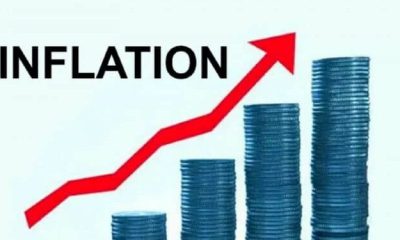Consumer Price Index
Top 10 most expensive Nigerian states to live in May 2024
The cost of living in Nigeria continues to rise, with May 2024 Consumer Price Index (CPI) data showing a consistent increase in inflation rates across both all items and food, affecting the daily lives of people in states.
The latest report from the National Bureau of Statistics (NBS) has put the nation’s inflation rate at 33.95% in May 2024. Inflation continues to bite hard across Nigeria, with varying impacts on different states.
However, food inflation, which is currently at 40.66%, is no longer a major driver of the all-item inflation rates in these states. While a number of the states recorded a decline in food inflation, all-item inflation remained high.
Here are the top 10 most expensive states to live in Nigeria as of May 2024, based on the latest all-item inflation rates:
#10 Kwara
Leaving its sixth position on the previous month’s list, Kwara experienced a decrease in both all-item and food inflation rates.
- The all-item inflation rate dropped by 1.33%-points, from 37.52% in April to 36.19% by May 2024.
- The food inflation rate decreased by 2.07–points to 44.66% from 46.73% the previous month.
- This indicates that the overall cost of living in Kwara was primarily driven by non-food items, as the reduction in food inflation was more significant compared to the all-item inflation rate.
#9 Kebbi
In Kebbi, the all-item inflation rate saw a slight increase of 0.23%-points, rising from 35.97% in April to 36.20% in May.
- Meanwhile, the food inflation rate marginally decreased by 0.09 %-points, from 38.59% to 38.50%.
- The near-stable food inflation rate suggests that the slight rise in the all-item inflation was driven by increases in the prices of non-food items.
#8 Bayelsa
Bayelsa experienced notable increases in both all-item and food inflation rates, with the all-item inflation rising by 2.66%-points from 34.06% in April to 36.72% in May.
- The food inflation rate also went up by 1.75%-points, from 40.54% to 42.29%.
- The inflation in Bayelsa was driven by both food and non-food items, with a significant contribution from non-food items given the larger increase in the all-item inflation rate.
#7 Abia
Dropping from its 10th position on the list in April 2024, Abia had the all-item inflation rate increased slightly by 0.25%-points, from 36.50% in April to 36.75% in May.
- Conversely, the food inflation rate decreased by 0.55%-points, from 44.56% to 44.01%.
- The inflationary pressure in Abia was more influenced by non-food items, as indicated by the increase in the all-item inflation rate despite the decrease in food inflation.
#6 Jigawa
Leaving its seventh position on the previous month’s list, Jigawa had minimal changes in both all-item and food inflation rates, with the all-item inflation rate increasing by 0.03%-points, from 37.31% in April to 37.34% in May, and the food inflation rate rising by 0.09%-points, from 42.48% to 42.57%.
The slight increases suggest that the inflation in Jigawa was balanced between food and non-food items.
#5 Lagos
After dropping out of the list for about two consecutive months and returning to the previous month’s list as the ninth most expensive state, Lagos, the commercial hub of Nigeria, experienced small increases in both all-item and food inflation rates.
- The all-item inflation rate rose by 0.24%-points, from 37.15% in April to 37.39% in May, and the food inflation rate increased by 0.04%-points, from 42.99% to 43.03%.
- This suggests that the inflationary pressure in Lagos was slightly more influenced by non-food items.
#4 Osun
From its eighth position in April 2024, Osun State took a step forward to a further position on the list in May 2024.
- In Osun, the all-item inflation rate increased by 0.28%-points, from 37.17% in April to 37.45% in May.
- However, the food inflation rate decreased by 1.05%-points, from 45.62% to 44.57%.
- This indicates that the inflation in Osun was driven more by non-food items, as evidenced by the increase in the all-item inflation rate despite a decrease in food inflation.
#3 Oyo
Maintaining the third position on the list from the previous month, Oyo saw a decrease in the all-item inflation rate by 0.65%-points, dropping from 38.37% in April to 37.72% in May.
- The food inflation rate also decreased slightly by 0.27%-points, from 43.53% to 43.26%.
- The more substantial decrease in the all-item inflation rate suggests that the overall cost of living reduction in Oyo was driven more by non-food items.
#2 Kogi
Kogi used to be the most expensive state in Nigeria consecutively.
- However, it has been unseated as it experienced a decrease in both all-item and food inflation rates, with the all-item rate falling by 1.46%-points, from 40.84% in April to 39.38% in May, and the food inflation rate dropping by 2.31%-points, from 48.62% to 46.31%.
- The larger decrease in food inflation indicates that the overall reduction in inflationary pressure in Kogi was primarily driven by lower food prices.
#1 Bauchi
- For the first time, Bauchi unseated Kogi as it experienced the highest increase in all-item inflation, rising by 2.39%-points, from 39.91% in April to 42.30% in May.
- The food inflation rate also saw an increase, albeit a smaller one, by 0.50%-points, from 33.85% to 34.35%.
- The significant rise in the all-item inflation rate suggests that the inflationary pressure in Bauchi was driven more by non-food items, despite the increase in food inflation.













